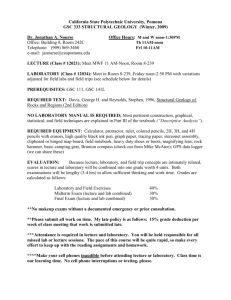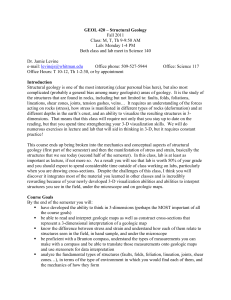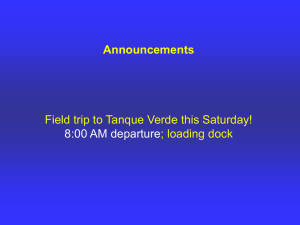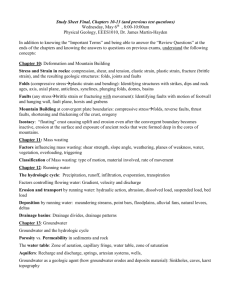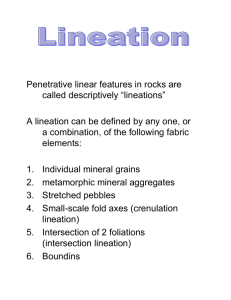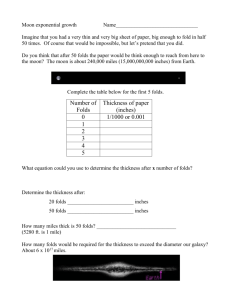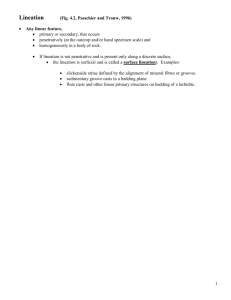STRUCTURAL GEOLOGY 313
advertisement
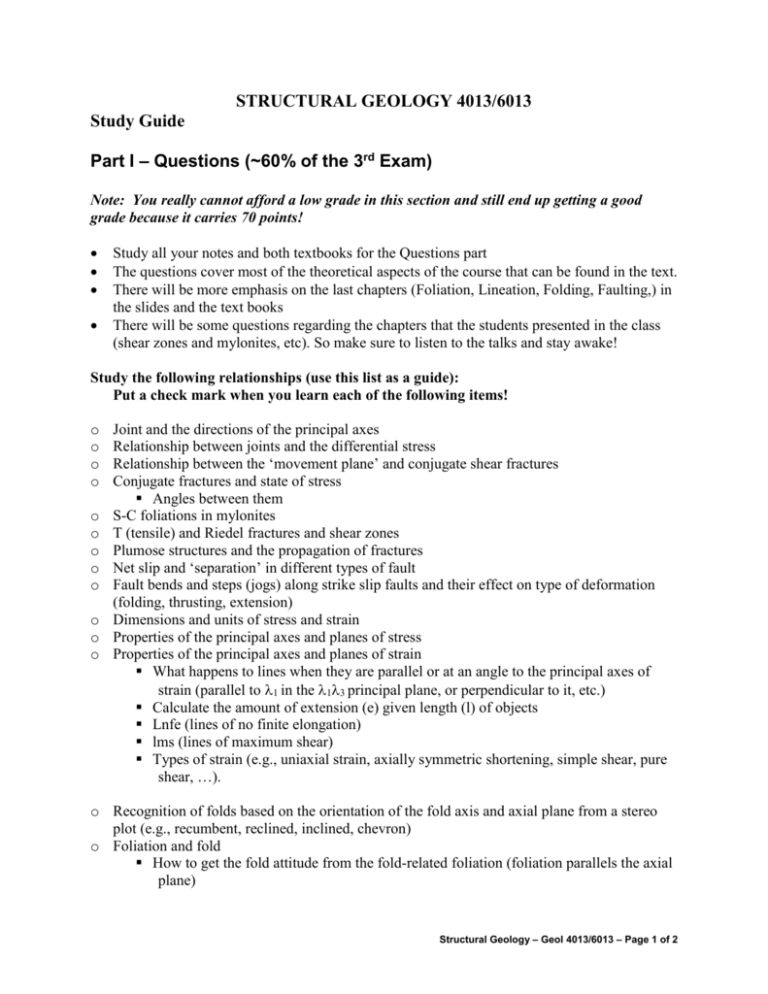
STRUCTURAL GEOLOGY 4013/6013 Study Guide Part I – Questions (~60% of the 3rd Exam) Note: You really cannot afford a low grade in this section and still end up getting a good grade because it carries 70 points! Study all your notes and both textbooks for the Questions part The questions cover most of the theoretical aspects of the course that can be found in the text. There will be more emphasis on the last chapters (Foliation, Lineation, Folding, Faulting,) in the slides and the text books There will be some questions regarding the chapters that the students presented in the class (shear zones and mylonites, etc). So make sure to listen to the talks and stay awake! Study the following relationships (use this list as a guide): Put a check mark when you learn each of the following items! o o o o o o o o o o o o Joint and the directions of the principal axes Relationship between joints and the differential stress Relationship between the ‘movement plane’ and conjugate shear fractures Conjugate fractures and state of stress Angles between them S-C foliations in mylonites T (tensile) and Riedel fractures and shear zones Plumose structures and the propagation of fractures Net slip and ‘separation’ in different types of fault Fault bends and steps (jogs) along strike slip faults and their effect on type of deformation (folding, thrusting, extension) Dimensions and units of stress and strain Properties of the principal axes and planes of stress Properties of the principal axes and planes of strain What happens to lines when they are parallel or at an angle to the principal axes of strain (parallel to 1 in the 13 principal plane, or perpendicular to it, etc.) Calculate the amount of extension (e) given length (l) of objects Lnfe (lines of no finite elongation) lms (lines of maximum shear) Types of strain (e.g., uniaxial strain, axially symmetric shortening, simple shear, pure shear, …). o Recognition of folds based on the orientation of the fold axis and axial plane from a stereo plot (e.g., recumbent, reclined, inclined, chevron) o Foliation and fold How to get the fold attitude from the fold-related foliation (foliation parallels the axial plane) Structural Geology – Geol 4013/6013 – Page 1 of 2 o How can you use boudins to determine the direction of strain axes (length of boudins parallels 2) o Mineral lineation and strain axes (stretching lineation parallels the X axis) o Crenulation lineation and So, S1, and S2 relationships o Cylindrical folds o Mode I, II, and II cracks o Griffith cracks o Mohr-Coulomb criterion o Tensile crack criterion o Von Mises Criterion o The angle that fractures form with respect to the principal stress axes o Effect of preexisting fractures vs. formation of new cracks on Mohr circle o What happens when cracks propagate under different modes of propagation (I, II, III) o Why joints are not very smooth when they are expected to be! o Relation of joints to bed thickness (length equals bed thickness) o Factors controlling joint spacing o Separation (apparent displacement vs. net slip (real displacement vector) o Significance of slip lineations on fault kinematics (at different increments) o Transpression o Transtension o Faults size and its displacement o Riedel fractures Their significance What do they tell us? o En-echelon fractures Sigmoidal veins Their shape Tell sense of shear from them o Pinnate fractures o Faults and differential stress o Anderson’s theory of faulting o Vergence of folds and how it can be applied to find the closure of large folds from vergence of minor folds (s- and z-shaped) o Effect of water on faulting and fracturing o Class of folds Parallel folds, class 1B Similar folds, class 2 and 3 o Superposed folding o Flexural folding vs. buckling, bending, vs. shear folding models o What happens to linear objects when they become folded o Types of foliation o Types of lineation o Everything in the textbook about folds, foliation, and lineation! Structural Geology – Geol 4013/6013 – Page 2 of 2
